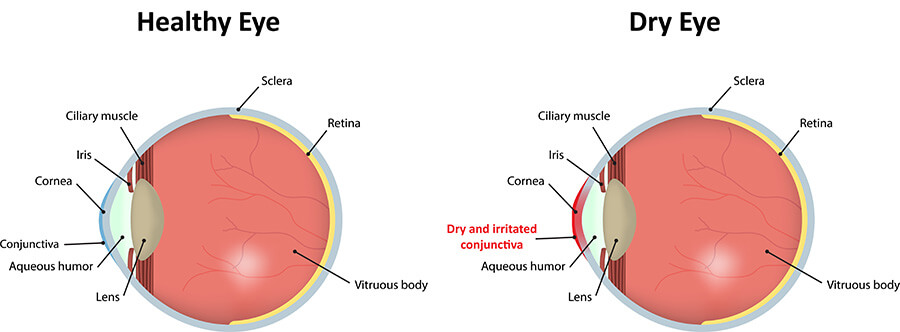What is Dry Eye?
Normally, our eyes have an adequate supply of natural tears. If you have Dry eye, you have a decrease in the quantity and/or quality of your natural tears usually because there is a decrease in tear production or an increase in tear evaporation. You can also have both.

Dry eye symptoms include:
- Itching
- Burning or stinging
- Redness
- Blurred vision that improves with blinking
- Excessive tearing
- Increased discomfort after prolonged reading or computer use
What Causes Dry Eye?
There are many reasons you may get dry eye including:
- Allergies
- Hormonal changes experienced during pregnancy as well as peri and post menopause
- Sjogrens autoimmune disease
- Medications such as antihistamines, antidepressants, oral contraceptives, and some heart medications
- Increasing age
- Certain diseases, like Sjogrens, rheumatoid arthritis, lupus, diabetes and thyroid
- Blepharitis as well as rosacea of the faceLow humidity environments such as dry, windy conditions, hot or cold climates, indoor heating or air conditioning
- Irritants such as smoke or dust
- Infrequent or incomplete blinking as well as incomplete lid closure at night while sleeping
- Eye surgery
- Glaucoma drops
What Should I Do if I Think I Have Dry Eye Disease?
The most prudent first step is to call us at 860 644-5011 for a dry eye screening since we need to examine your eye. Rather than one size fits all, there are several treatment options we can discuss together.
What Are Some Treatment Options for Dry Eye?
- If your Dry eye is mild, artificial tears may be helpful. We believe that even for mild cases, you should call our office for a screening and best way to proceed and certainly if artificial tears have not worked.
- If you feel any symptoms, we will will examine your eye and propose some solutions that are right for your particular case
In general, you can try to: - Reduce or limit screen time on devices
- Wear glasses/sunglasses to reduce wind exposure
- Avoid waterproof mascara and eyeliner
- Avoid forced air exposure on your eyes from your car defroster; use floor defroster setting
- Reduce exposure to smoke around your eyes
- Use daily contact lenses
- Use a humidifier at home or in the office
The latest approach to dry eye: TrueTear® – FDA Approved Dry Eye Tear Device
TrueTear® is a prescription device that uses neurostimulation for cases of dry eye caused by inadequate tear production. The easy-to-use, portable TrueTear device is completely drug-free and does not involve using any preservatives or chemicals in the eye.
When the TrueTear unit’s disposable tips are placed inside the nose, they deliver gentle pulses of energy to the nerve in the nasal cavity, near the bridge of the nose. This sends a message to the brain, which then sends a message to the tear glands in the eyelids to produce more natural tears.
The treatment can easily fit into your daily routine and it works quickly. In only a few seconds per day, TrueTear can turn your eye’s natural tear system back on, providing significant relief from dry, irritated eyes.
TrueTear can be used to enhance the effects of other dry eye treatments or to help you if you have reached a plateau in your current treatments.
If you are interested in learning more about TrueTear, please call our office at (860) 644-5011 to schedule your appointment.




